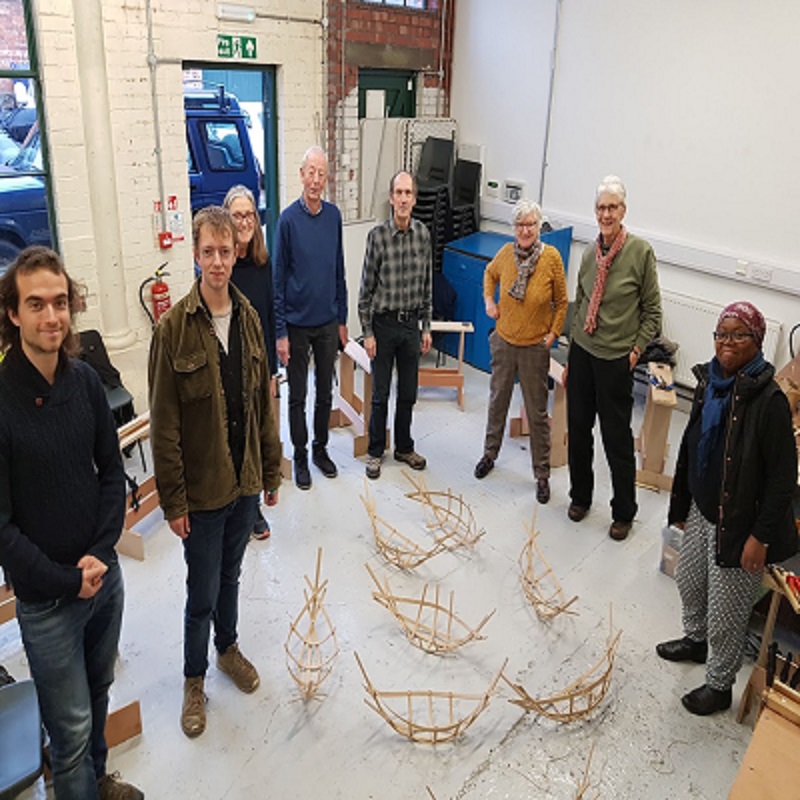In November Underfall Yard was delighted to welcome boatbuilder Gail McGarva to run her Disappearing Lines boatbuilding workshop. Underfall Yard volunteer writer Andrew Radford takes up the story.
Having only recently joined the Underfall Yard volunteer force, and spent some time reading the website, I saw mention of this workshop and signed up. Between doing so and the day of the event I had many moments of doubt wondering what on earth was a 74-year-old landlubber with few practical skills doing attending a boat building workshop? But it was great to step outside my comfort zone and be able I to spend the day with the remarkable traditional boat builder and storyteller, Gail McGarva

Supported by Arts Council England, Gail is currently touring the country with her Disappearing Lines workshops and in coming to Underfall Yard she was, in a sense, coming home, as she had lived on boats for many years in Bristol docks and the River Avon when, in her early career, she worked as a British Sign language interpreter. In 2003 she knew that she wanted to work with boats and in 2004 she trained at the Boat Building Academy in Lyme Regis. Since then, she has crafted a number of traditional, clinker built boats – firstly Cornish Pilot Gigs – 32ft racing rowing boats, and, latterly, Lerrets – a boat type native to Lyme Bay, where Gail is based.
Gail explained that her mission is firstly to preserve boat types which are in danger of extinction, the ‘ghost ships’ which are teetering on the brink and secondly to preserve the art of boatbuilding ‘by eye’ and without drawings or plans. She meets this twin objective not by restoring the original vessel, the ‘motherboat’ as Gail terms it, but by building a ‘daughter boat’ by eye with lines taken from the motherboat. So, the retired fishing lerret Vera, built in 1923, was the motherboat to Gail’s 2010 daughterboat Littlesea and Vera has become the ‘Story Boat’, inverted and on wheels and now a mini maritime museum which Gail tours to schools and community groups.
In order that we might have a taste of her modus operandi, Gail had prepared a number of miniature skeleton boats, one for each of the nine of us, to advance to their next stage of construction by the addition of ribs. She cranked up her mobile steam oven, powered by a wallpaper stripper, into which she placed strips of oak to steam in preparation for our session. We would then be able to bend strips, whilst still malleable, into our skeletons, shaping them by eye to create three ribs each side & clamp in place for the strips to cool and set, later to be firmly fixed in place with copper nails and rivets. What could possibly go wrong!
The first part of the exercise seemed to go fairly smoothly for all of us but then moving onto fixing them in place with the copper nails and rivets proved less straightforward, with ribs moving out of place and nails bending. But Gail, patience and calmness personified, came to our aid amongst all the hammering and riveting. I bent many nails and rivets but always came the reassuring voice of Gail “Don’t worry I think we can rescue that” – and so it proved.
This practical exercise gave all of us a glimpse of the incredible skill, sensitivity & love which goes into the traditional method of clinker boatbuilding. We all left with our own miniature ‘Ghost ship’ and gratitude for the opportunity to spend time with and learn from a master practitioner of the craft. Thank you, Gail, for your generosity in sharing your time and knowledge with us at Underfall Yard.
